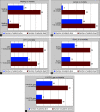Mottling in Septic Shock: Ethnicity and Skin Color Matter
- PMID: 38074963
- PMCID: PMC10701570
- DOI: 10.5005/jp-journals-10071-24586
Mottling in Septic Shock: Ethnicity and Skin Color Matter
Abstract
Background: Skin mottling as a clinical perfusion marker in septic shock is significantly associated with severity and outcome in white-skinned population and its validity as a clinical sign in dark-skinned population is not known. The objectives of this study were to evaluate mottling in septic shock in the Indian ethnic population who has different skin color as compared to the white-skinned population and to assess mottling as an outcome predictor with capillary refill time (CRT) and other biochemical parameters which are the established clinical markers of perfusion in septic shock.
Materials and methods: We conducted a prospective observational study of patients with skin color categories 21-34 on the von Luschan scale or Fitzprick type IV-VI who had septic shock needing a high dose of norepinephrine ≥0.2 μg/kg/min after fluid optimization. The study was conducted in a mixed medical-surgical ICU over 12 months. Two blinded experts (a Dermatologist and a plastic surgeon) independently classified the skin type, validated the occurrence of mottling, and scored mottling in our patients. We recorded the demographics, hemodynamic variables, and mottling score and observed the incidence of mottling and its correlation with predictors of the severity of septic shock. We also compared CRT, arterial lactate, central venous oxygen saturation, and venoarterial PCO2 gap with occurrence of mottling in septic shock patients.
Results: We included 108 patients with age 61 ± 16 years. Mean Sequential Organ Failure Assessment (SOFA) and Acute Physiology and Chronic Health Evaluation (APACHE) II scores at enrolment were 10.3-21.9, respectively. Incidence of mottling was 20.3% (22/108). CRT >3 seconds was observed in 50.9% (55/108). Development of mottling was significantly associated with 90-day mortality; 20/22 (90.9%) patients died in the mottling group versus 58/86 (65.1%) in the non-mottling group (p = 0.028). Capillary refill time >3 seconds did not corelate with mortality; 40/55 (72.7%) Patients with CRT >3 seconds died versus 32/53 (60.4%) patients died in CRT ≤3 seconds group. Occurrence of mottling could predict mortality; positive predictive value of 90.9% which was comparable to positive predictive value of lactate levels >4 mmol/L, i.e., 94.1%.
Conclusion: The incidence of mottling in septic shock is much less in patients of Indian ethnicity with brown skin color than in white-skinned population. Occurrence of mottling and not delayed CRT, is a better predictor of outcome in this setting.
How to cite this article: Jog SA, Narasimhan VL, Rajhans PA, Akole PV, Pawar B, Bhurke B, et al. Mottling in Septic Shock: Ethnicity and Skin Color Matter. Indian J Crit Care Med 2023;27(12):902-909.
Keywords: Capillary refill time; Non-white skin colored patient population; Outcome; Septic shock; Skin mottling.
Copyright © 2023; The Author(s).
Conflict of interest statement
Source of support: Nil Conflict of interest: None
Figures



References
-
- Hernández G, Ospina-Tascón GA, Damiani LP, Estenssoro E, Dubin A, Hurtado J, et al. Effect of a resuscitation strategy targeting peripheral perfusion status vs serum lactate levels on 28-day mortality among patients with septic shock. JAMA. 2019;321(7):654–664. doi: 10.1001/jama.2019.0071. - DOI - PMC - PubMed
-
- Shankar-Hari M, Phillips GS, Levy ML, Seymour CW, Liu VX, Deutschman CS, et al. Sepsis definitions task force. Developing a new definition and assessing new clinical criteria for septic shock: For the third international consensus definitions for sepsis and septic shock (Sepsis-3). JAMA. 2016;315(8):775–787. doi: 10.1001/jama.2016.0289. - DOI - PMC - PubMed
LinkOut - more resources
Full Text Sources
Research Materials
Miscellaneous
